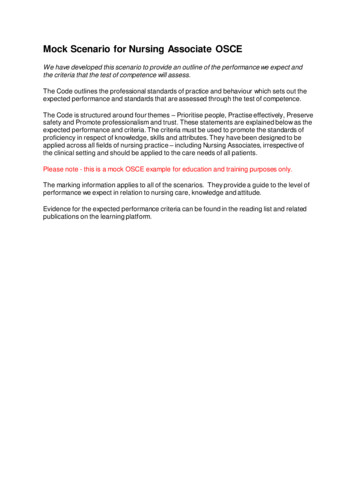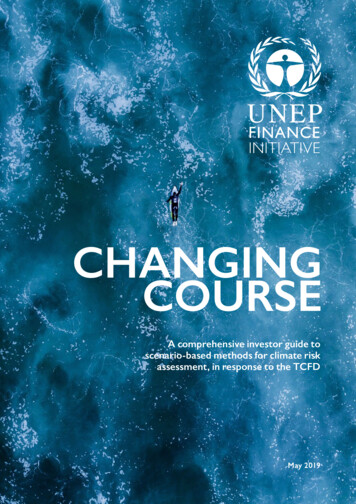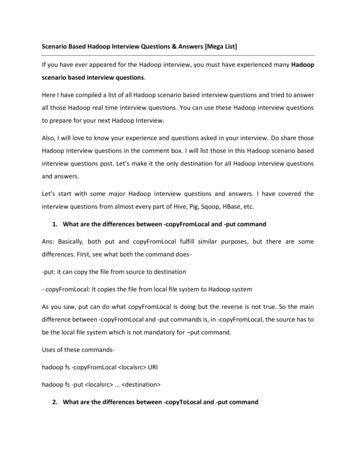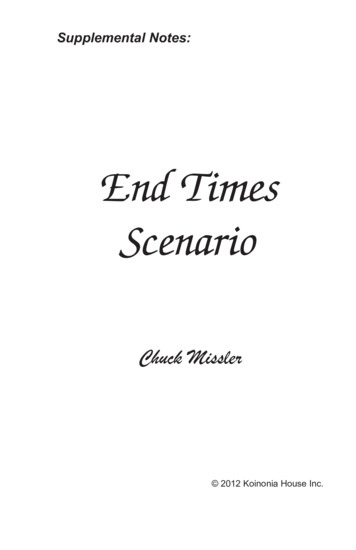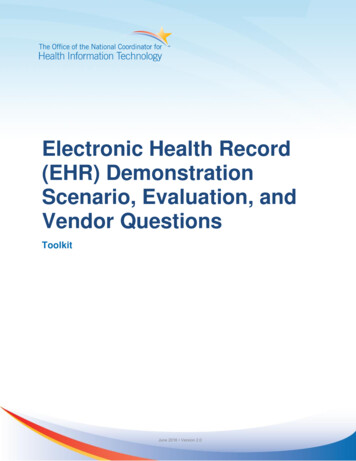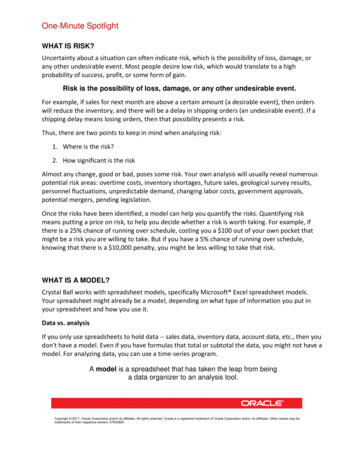
Transcription
One-Minute SpotlightWHAT IS RISK?Uncertainty about a situation can often indicate risk, which is the possibility of loss, damage, orany other undesirable event. Most people desire low risk, which would translate to a highprobability of success, profit, or some form of gain.Risk is the possibility of loss, damage, or any other undesirable event.For example, if sales for next month are above a certain amount (a desirable event), then orderswill reduce the inventory, and there will be a delay in shipping orders (an undesirable event). If ashipping delay means losing orders, then that possibility presents a risk.Thus, there are two points to keep in mind when analyzing risk:1. Where is the risk?2. How significant is the riskAlmost any change, good or bad, poses some risk. Your own analysis will usually reveal numerouspotential risk areas: overtime costs, inventory shortages, future sales, geological survey results,personnel fluctuations, unpredictable demand, changing labor costs, government approvals,potential mergers, pending legislation.Once the risks have been identified, a model can help you quantify the risks. Quantifying riskmeans putting a price on risk, to help you decide whether a risk is worth taking. For example, ifthere is a 25% chance of running over schedule, costing you a 100 out of your own pocket thatmight be a risk you are willing to take. But if you have a 5% chance of running over schedule,knowing that there is a 10,000 penalty, you might be less willing to take that risk.WHAT IS A MODEL?Crystal Ball works with spreadsheet models, specifically Microsoft Excel spreadsheet models.Your spreadsheet might already be a model, depending on what type of information you put inyour spreadsheet and how you use it.Data vs. analysisIf you only use spreadsheets to hold data -- sales data, inventory data, account data, etc., then youdon't have a model. Even if you have formulas that total or subtotal the data, you might not have amodel. For analyzing data, you can use a time-series program.A model is a spreadsheet that has taken the leap from beinga data organizer to an analysis tool.Copyright 2017, Oracle Corporation and/or its affiliates. All rights reserved. Oracle is a registered trademark of Oracle Corporation and/or its affiliates. Other names may betrademarks of their respective owners. 07003600
Risk Analysis, continuedA model represents a process with combinations of data, formulas, and functions. As you add cellsthat help you better understand and analyze your data, your data spreadsheet becomes aspreadsheet model.TRADITIONAL SPREADSHEET RISK ANALYSISIdentifying risks in your spreadsheetSo now you realize that you already have a model, or you create your first model. You might noticethat your model has some values in it that you are unsure of. Perhaps you don’t have the actualdata yet (this month’s sales figures) or the value varies unpredictably (individual item cost).For each component, or variable, of the model (e.g., costs, rates, demands), you can ask yourself,"How sure am I of this value? Will it vary? Is this a best estimate or a known fact?" Since youconstructed the model, you will probably be quick to identify which variables these are. This lackof knowledge about particular values, or the knowledge that some values may always varycontribute to the model's uncertainty, helps you to identify your risks.The traditional modeling landscapeTraditionally, spreadsheet analysis tried to capture this uncertainty in one of three ways: Pointestimates, Range estimates, and What-if scenarios. Point estimates are when you use what you think are the most likely values (technicallyreferred to as the mode) for the uncertain variables. These estimates are the easiest, butcan return very misleading results.For example, try crossing a river with an average depth of three feet. Or, if it takes you anaverage of 25 minutes to get to the airport, leave 25 minutes before your flight takes off.You will miss your plane 50% of the time. Range estimates typically calculate three scenarios: the best case, the worst case, and themost likely case. These types of estimates can show you the range of outcomes, but notthe probability of any of these outcomes. What-if scenarios are usually based on the range estimates, and calculate as manyscenarios as you can think of. What is the worst case? What if sales are best case butexpenses are the worst case? What if sales are average, but expenses are the best case?What if sales are average, expenses are average, but sales for the next month are flat? Asyou can see, this form of analysis is extremely time consuming, and results in lots of data,but still doesn’t give you the probability of achieving different outcomes.2
Risk Analysis, continuedSpreadsheet Risk AnalysisYou can perform a risk analysis in several ways, but one method involves building a spreadsheetmodel. A good spreadsheet model can be very helpful in identifying where your risk might be,since cells with formulas and cell references identify causal relationships among variables.One of the drawbacks of conventional spreadsheet models, however, is that you can only enterone value in a cell at a time. Why would you want to put more than one value in a cell, you ask?Remember those uncertain values that you could represent either with point estimates, rangeestimates, or what-if scenarios? A spreadsheet will not allow you to enter a range or multiplevalues for a cell, only one value at a time. So calculating the range requires you to replace theuncertain value several times to see what effect the minimum, most likely, and maximum valueshave.Calculating more realistic "what-if" scenarios is the same, except it requires you to change yourspreadsheet even more. And don’t forget to keep track of all the results somewhere, or you willhave to repeat the scenario!3
Risk Analysis, continuedThis is where Crystal Ball comes in.Crystal Ball helps you define those uncertain variables in a whole new way: by defining the cellwith a range or a set of values. So you can define your business phone bill for future months as anyvalue between 2500 and 3750, instead of using a single point estimate of 3000. It then usesthe defined range in a simulation. In addition, Crystal Ball keeps track of the results of eachscenario for you.WHAT IS MONTE CARLO SIMULATION?What do we mean by "simulation?"When we use the word simulation, we refer to any analytical method meant to imitate a real-lifesystem, especially when other analyses are too mathematically complex or too difficult toreproduce.Without the aid of simulation, a spreadsheet model will only reveal a single outcome, generallythe most likely or average scenario. Spreadsheet risk analysis uses both a spreadsheet model andsimulation to automatically analyze the effect of varying inputs on outputs of the modeled system.One type of spreadsheet simulation is Monte Carlo simulation,which randomly generates values for uncertain variables over andover to simulate a model.How did Monte Carlo simulation get its name?Monte Carlo simulation was named for Monte Carlo, Monaco, where the primary attractions arecasinos containing games of chance. Games of chance such as roulette wheels, dice, and slotmachines, exhibit random behavior.The random behavior in games of chance is similar to how Monte Carlo simulation selects variablevalues at random to simulate a model. When you roll a die, you know that either a 1, 2, 3, 4, 5, or 6will come up, but you don't know which for any particular roll. It's the same with the variables thathave a known range of values but an uncertain value for any particular time or event (e.g. interestrates, staffing needs, stock prices, inventory, and phone calls per minute).What do you do with uncertain variables in your spreadsheet?For each uncertain variable (one that has a range of possible values), you define the possiblevalues with a probability distribution. The type of distribution you select is based on the conditionssurrounding that variable. Distribution types include:4
Risk Analysis, continuedTo add this sort of function to an Excel spreadsheet, you would need to know the equation thatrepresents this distribution. With Crystal Ball, these equations are automatically calculated foryou. Crystal Ball can even fit a distribution to any historical data that you might have.What happens during a simulation?A simulation calculates multiple scenarios of a model by repeatedly sampling values from theprobability distributions for the uncertain variables and using those values for the cell. Crystal Ballsimulations can consist of as many trials (or scenarios) as you want - hundreds or even thousands in just a few seconds.During a single trial, Crystal Ball randomly selects a value from the defined possibilities (the rangeand shape of the distribution) for each uncertain variable and then recalculates the spreadsheet.HOW DO YOU ANALYZE THE RESULTS OF A SIMULATION?For every spreadsheet model, you have a set of important outputs, such as totals, net profits, orgross expenses, which you want to simulate and analyze. Crystal Ball lets you define those cells asforecasts.A forecast is a formula or output cell that you want to simulate and analyze.You can define as many forecasts as you need, and when you run a Monte Carlo simulation withCrystal Ball, Crystal Ball remembers the values for each forecast for each trial.During the simulation, you can watch a histogram of the results, referred to as a Frequency Chart,develop for each forecast. While the simulation runs, you can see how the forecasts stabilizetoward a smooth frequency distribution. After hundreds or thousands of trials, you can view thestatistics of the results (such as the mean forecast value) and the certainty of any outcome. Theexample below is a forecast for Total Remediation Cost.5
Risk Analysis, continuedWHAT IS CERTAINTY?Certainty is the percent chance that a particular forecast value will fall within a specified range. Forexample, in the chart above, you can see the certainty of the remediation project costing morethan 8,600 by entering the 8,600 amount as the lower limit. Of the 2000 trials that were run,64.79% of those had a cost greater than 8,600, so your certainty of the remediation costing morethan 8,600 is 64.79%.Certainty is the percent chance that a particular forecast valuewill fall within a specified range.Therefore, the forecast results not only show you the different result values for each forecast, butalso the probability of any value. Other charts allow you to examine different facets of your model:The Sensitivity Chart lets you analyze the contribution of the assumptions (the uncertainvariables) to a forecast, showing you which assumptions have the greatest impact on that forecast.What factor is most responsible for the uncertainty surrounding your net profit? Which geologicalassumptions are most important when calculating oil reserves? Sensitivity analysis lets you focuson the variables that matter most.The Overlay Chart lets you display multiple forecasts on the same axis, even when the forecastsare from separate spreadsheet models. Which of six potential new projects has the highestexpected return with the least variability (smallest range of values) surrounding the mean? Withthe Overlay Chart, you can compare and select the best alternatives.The Trend Chart lets you stack forecasts so that you can examine trends and changes in a series.How do your risks change over time?WHAT IS OPTIMIZATION?Optimization is a process that finds a best, or optimal, solution for your model. Not everyspreadsheet model requires optimization; however, the technique is very important when youhave model variables that you can control (e.g., spending) and you want a maximum or minimumgoal that relies on those variables.For example, you want to know the maximum possible return on an investment portfolio, but youare not sure how much money to put into each separate investment. Or, you are a projectmanager with budget constraints, and you need to figure out which combination of seven possibleprojects will result in the highest profit. Or, you are a petroleum engineer, and you mustdetermine the optimal number of oil wells to drill given a certain reservoir size and specifiedproduction rates.6
Risk Analysis, continuedWith traditional spreadsheet models, you can perform simple optimizations with programs such asExcel's Solver, which applies linear equations to come up with a maximum or minimum value. Thisworks fine if your problem has a single optimal value, like the top of a mountain.In reality, such simple situations are rare, and more often than not, you are searching for thehighest peak in a whole range of mountains. You must discern which of the high values is thehighest, and you need to perform a more global optimization.OptQuest, the Crystal Ball optimizer, performs both linear and nonlinear global optimizations, andmost importantly, it works with Crystal Ball to perform optimizations given the uncertainconditions. With OptQuest, you can find an optimal value when variables in the model areuncertain and change over time.WHAT IS TIME-SERIES FORECASTING?Time-series forecasting is a forecasting method that uses a set of historical values to predict anoutcome. These historic values, often referred to as a "time series", are spaced equally over timeand can represent anything from monthly sales data to daily electricity consumption to hourly callvolumes.Time-series forecasting assumes that a time series is a combination of a pattern and some randomerror. The goal is to separate the pattern from the error by understanding the pattern's trend, itslong-term increase or decrease, and its seasonality, the change caused by seasonal factors such asfluctuations in use and demand.How does CB Predictor work?CB Predictor analyzes the trend, seasonality, and error in your data and then projects them intothe future to predict likely results. The software can fit your data to eight different time-seriesmethods, four seasonal and four non-seasonal, and it will automatically rank those methods toshow you which ones come closest to fitting your data.But what if your time-series data is dependent on outside influences, such as weather or regularsales promotions? CB Predictor can perform linear regression; a method of time-series forecastingthat determines the relationship between the dependent variables and your data and uses thatrelationship to improve your forecast.WHAT ARE THE BENEFITS OF RISK ANALYSIS WITH ORACLE’S CRYSTAL BALL?You stop guessing.While everyone must take risks to succeed, blind risks too often lead to costly errors. Crystal Ballputs the odds in your favor by helping you choose the most promising calculated risks. Each timeyou perform a Crystal Ball simulation, you gain a richer understanding of the inherent risks.You break free from the limitations of spreadsheets.7
Risk Analysis, continuedMonte Carlo simulation frees you from the constraints of estimates and best-guess values. Whyrely on a single, possibly misleading estimate when you can easily create and analyze thousands ofpotential outcomes? Plus, using Crystal Ball means you no longer need to create severalspreadsheets to analyze multiple scenarios.You have a competitive advantage.With a Crystal Ball analysis, you know what your competitor does not: the probability of aparticular outcome. Because Crystal Ball lets you quantify your risks, it can be a crucial tool for asuccessful negotiation.You know what matters.With Crystal Ball's Sensitivity Analysis you will know which factors really drive results. You canfocus your energies on the right problem and complete the analysis sooner with less effort.You look sharp.Smart decisions alone aren't enough. You need to communicate your decisions. Crystal Ball'sgraphics and reports are the professional way to show your clients, investors, and managementthat you thought of all the angles and made informed choices.For more information or to contact us, browse stalball/overview/index.html.8
will reduce the inventory, and there will be a delay in shipping orders (an undesirable event). If a . specifically Microsoft Excel spreadsheet models. . simulation to automatically analyze the effect of varying inputs on outputs of the modeled system.


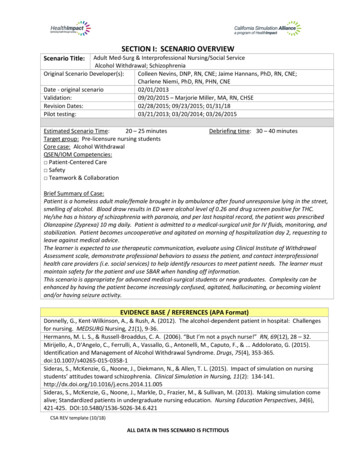
![Informatica Interview Questions and Answers [Scenario-Based]](/img/2/informatica-interview-questions-and-answers-scenario-based-1.jpg)
